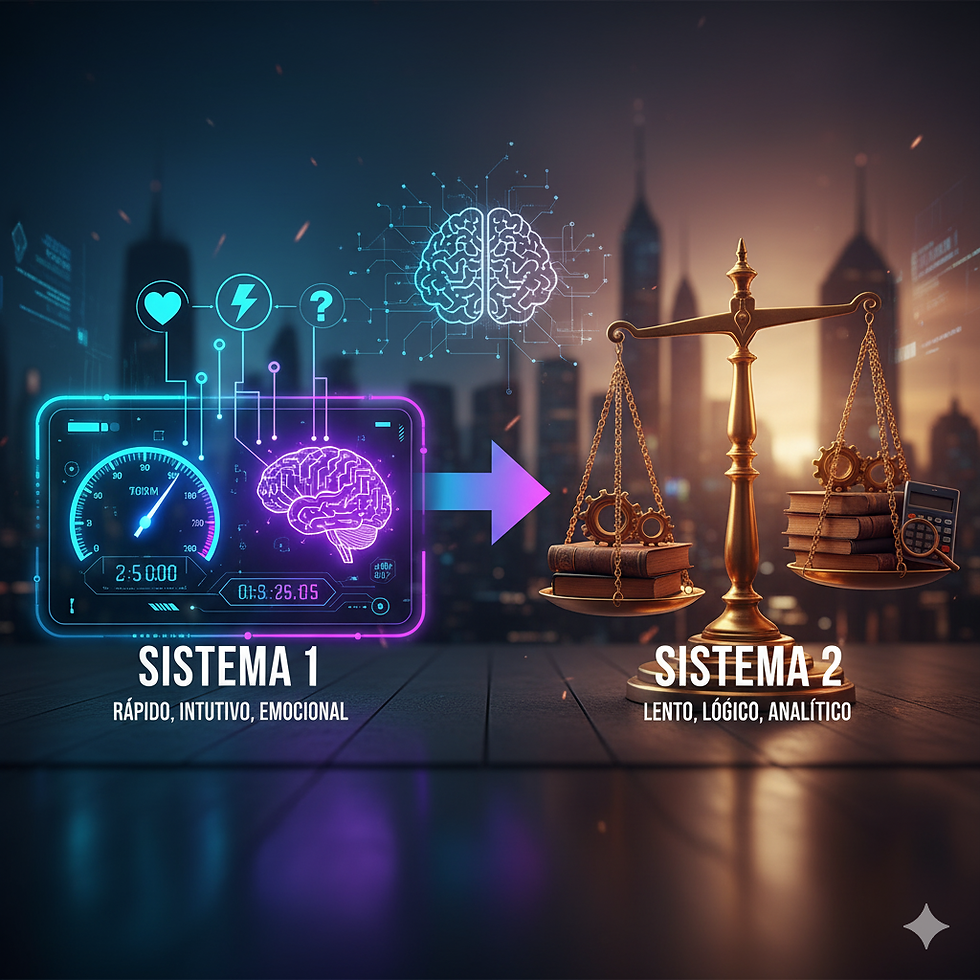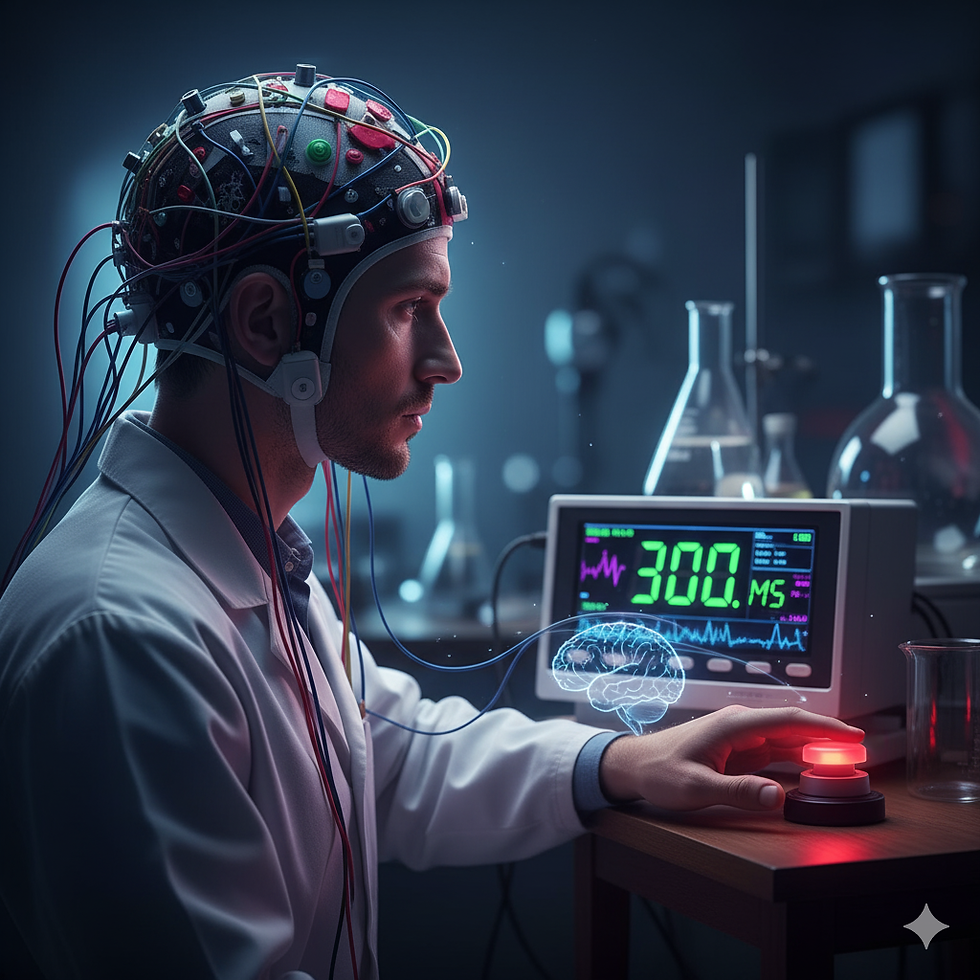WHAT DOES SCIENCE SAY ABOUT INTUITION?
- Marcela Emilia Silva do Valle Pereira Ma Emilia
- Sep 2
- 5 min read

🧠 What does science say about intuition?
Intuition is a word that sparks curiosity. It is often called the “sixth sense,” associated with hunches or that inner voice that seems to guide us in certain situations. However, far from being something mystical or supernatural, science shows that intuition is a real process of the human brain — fast, unconscious, and strongly based on our life experience.
🔬 What is intuition from a scientific point of view

Intuition is not magic, it is fast processing!
From the point of view of neuroscience and psychology, intuition is a process of quick and automatic judgment that happens without our full awareness. It results from the interaction between past experiences, implicit memories, emotions, and learned patterns that are accessed by the brain almost instantly. In other words, as already mentioned in other posts, this is what Daniel Kahneman, Nobel Prize winner, described in his famous book Thinking, Fast and Slow:
System 1: fast, intuitive, automatic, emotional.
The brain stores experiences and patterns implicitly. Therefore, when one “intuits,” it is because it is accessing that database without thinking about the logic step by step. The brain already has the decision made before it becomes conscious.
The research of Benjamin Libet, in the 1980s, in which volunteers were asked to move their wrist or finger whenever they wanted, without warning, while he measured brain activity with EEG (electroencephalogram), discovered exactly this. Before the person reported that they had decided to move their finger or wrist, the brain already showed a decision potential 300–500 milliseconds earlier.

Neuroscientist António Damásio brought another complementary perspective with his somatic marker theory. For him, the emotions recorded in our past experiences leave “marks” that help the brain decide more quickly in similar situations in the future. Thus, intuition is also emotional — it is shaped by the feelings we associate with our memories.
From a neurological point of view, structures such as the ventromedial prefrontal cortex, the amygdala, and the hippocampus are directly involved in this process, in addition to circuits linked to implicit memory and learning.
⚖️ Intuition and the Second Brain

It may sound strange, mystical, but yes, intuition and the stomach (and the entire intestinal tract, by the way) are deeply interconnected — and neuroscience can explain this.
The stomach and the entire intestinal tract have the largest network of neurons in the body, excluding the brain, with more than 100 million neurons, and is called the enteric nervous system. And it is so complex that some neuroscientists call it the second brain.
To begin with, more than 90% of the body’s serotonin (the neurotransmitter of good mood and well-being) is produced in the intestine. In other words, how you feel will directly reflect in your intestinal content. And not only that, this abdominal region also influences the neurotransmitters dopamine and GABA, intervening in how we perceive risks and rewards. Therefore… in how we intuit.
Both neurons and neurotransmitters are connected and communicate with the brain through the vagus nerve (the nerve that connects the intestine to the brain). And when you feel that “butterflies in your stomach” or that “tightness in your belly,” it is literally a signal of the nervous system going up from there to the brain. That is why, in situations of anxiety/important decisions, we say that the gut speaks (cold in the stomach, knot in the belly, butterflies).
This communication is bidirectional: it is not only from the intestine/stomach to the brain, but also the other way around, with responses to emotional states.
From a neuroscientific point of view, these bodily sensations that serve as guides are called interoception: the brain’s ability to perceive internal body signals (heartbeat, breathing, stomach, ...). So, neuroscience is showing that intuition is not only mental, but a combination of bodily somatic cues. The insula, in the brain, interprets these bodily signals and integrates them with emotions and memories, thus giving rise to the feeling that “I have a hunch.”
🧪 Scientific evidence about intuition

Studies show that experts use intuition more efficiently than beginners, precisely because they have a greater repertoire of experiences stored in the brain. Intuition, in these cases, is nothing more than the quick expression of this accumulated knowledge.
Intuition, then, is useful in familiar and recurring contexts, in which we have already accumulated experience, or in other words, the brain already has the accumulated patterns. It is the case of an experienced doctor who, just by observing a patient, can notice subtle signs of a disease even before having all the tests in hand.
But this does not mean that one can blindly trust the intuition of these people. In new, complex, or high-impact situations, it can be risky. Investors, for example, who follow only “a hunch” can be victims of cognitive biases, such as overconfidence or anchoring.
An active participant in intuition is the ventromedial prefrontal cortex (vmPFC). It is the key to integrating emotion plus experience and generating the sensation of “right or wrong.”
A classic example of the participation of the vmPFC is the experiment of Antoine Bechara and António Damásio et al. (1997), the Iowa Gambling Task (IGT). The test consisted of a gambling game, in which the decks were consciously advantageous, there was a logic of gain. However, a factor of reward and punishment was created in such a way that it almost created a real conflict of immediate attraction and delayed probabilistic reward or punishment. And the interesting thing here was that the participant had to choose in advance whether they wanted to play to win or lose everything, betting if the card would turn out good or bad. But the test showed that people already sweated in their hands (bodily response) and the brain showed activity in the vmPFC even before they decided rationally. In other words, the body and the brain already “knew” intuitively before the conscious mind understood.
People who have damage to the vmPFC end up being deprived of the somatic/emotional signal, relying only on a cost vs. benefit analysis that is often conflicting, involving immediate and future consequences. Therefore, their ability to evaluate bodily signals is impaired, leading to a disadvantageous choice.
🎯 Practical applications

Science suggests some guidelines about when to trust and when to distrust intuition:
When to trust:
In familiar situations, in which we have already accumulated experience.
In everyday and quick decisions, in which spending analytical energy would be unnecessary.
When to distrust:
In new or highly complex scenarios.
When much is at stake and the risk of error is high.
The most effective, according to research, is to combine intuition with analytical reasoning. This integration ensures more balanced decisions, taking advantage of the speed of intuition and the caution of reason.
🌟 Conclusion

Intuition is not magic. It is the result of the sophisticated functioning of our brain, which accesses memories, emotions, and patterns unconsciously and quickly. At many moments, it guides us with surprising efficiency. At others, it can lead us to predictable errors.
Intuition is an economy of energy that is sometimes necessary and makes a difference in the lives of experts. In fact, in some Eastern traditions intuition is seen as higher wisdom. But neuroscience, on the other hand, shows how this is the result of learning + emotion.
What science shows is that intuition and reason are not enemies, but partners. Knowing when to trust the first and when to resort to the second is the key to wiser and more balanced decisions.
📚 References and recommended readings
Kahneman, D. Thinking, Fast and Slow.
Damásio, A. Descartes’ Error.
Gigerenzer, G. Gut Feelings: The Intelligence of the Unconscious.
Articles in Psychological Science and Nature Human Behaviour on heuristics and cognitive biases.


Comments